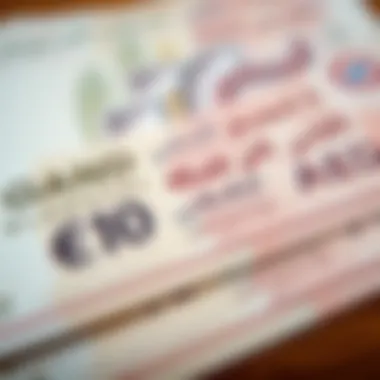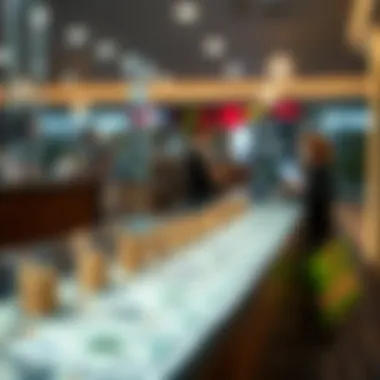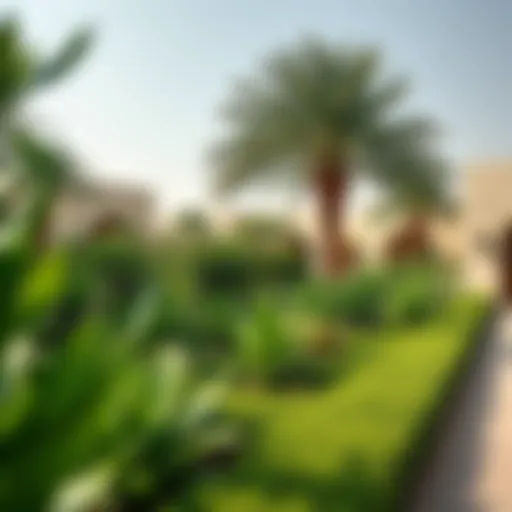Understanding Currency Exchange: 61 USD to AED


Intro
The interplay between currencies is a dance not only of numbers but also of economic forces and market sentiments. In the context of converting 61 United States dollars (USD) into United Arab Emirates dirhams (AED), many factors come into play. Understanding this process isn't just for frequent travelers; it's crucial for investors and homebuyers looking to dive deep into Dubai’s thriving real estate market.
Currency exchange is often affected by varying factors: economic conditions, geopolitical stability, and even market psychology. The dirham is pegged to the dollar, which lends it a degree of stability that many investors find attractive. However, fluctuations do happen, and being aware of these nuances is essential for anyone looking to engage in the region's dynamic property sector.
To understand how 61 USD translates into AED, we'll explore market trends, investment opportunities, and the broader implications of these financial movements. So, grab your coffee and let's delve into the economy that drives Dubai's real estate scene.
Understanding Currency Exchange
Currency exchange gets a lot of chatter, especially these days when folks travel more and invest internationally. When considering converting 61 USD to AED, grasping the underlying concepts of currency exchange becomes pivotal. This isn’t merely about numbers; it’s about comprehending how global economies interconnect and how those connections affect your finances, especially when dealing with real estate in Dubai.
The Basics of Currency Conversion
At its core, currency conversion is pretty simple. You have one currency—like the United States dollar (USD)—and you want to swap it for another, say, the United Arab Emirates dirham (AED). The beauty lies in the exchange rate, which decides how many AED you get per dollar. It’s not just a straight swap; it involves several nuances that could impact the final amount you receive.
Several factors can influence this basic transaction. For instance, if the USD is strong, you may get more AED in return. Conversely, if the dollar weakens, your conversion yield may take a hit. This interplay is crucial for anyone thinking about investing in a foreign market. An understanding of these basics not only aids in making informed decisions but also in planning your budget accurately.
How Exchange Rates Are Determined
The mechanics of exchange rates sound a bit complex, but they can be boiled down to a few fundamental elements. First off, supply and demand play a massive role. If more people want dollars than AED, the value of the dollar appreciates, leading to a favorable exchange rate for your conversion. Conversely, if the dirham is in higher demand, it might take more dollars to get the same amount of AED.
Beyond mere demand-supply dynamics, several economic indicators also play a role:
- Interest Rates: Higher interest rates can attract foreign capital, leading to a stronger currency.
- Inflation Rates: Generally, a lower inflation rate in a country increases that country’s currency value.
- Political Stability: Countries with less risk are more attractive to foreign investors, which can elevate the currency’s demand.
Understanding these elements equip you with the knowledge needed to make sensible currency conversion decisions. It highlights that while the figures may change rapidly, they’re grounded in broader economic realities.
"Converting currency isn’t just about today’s rates; it’s about understanding the forces at play in global finance."
Knowing how exchange rates are determined lets you anticipate shifts. As an investor looking at making a splash in Dubai’s thriving market, these insights can spell the difference between a profitable venture and a monetary misstep.
Current Rate Analysis
Understanding the current exchange rate between the United States dollar (USD) and the United Arab Emirates dirham (AED) is not just a numbers game; it’s a fundamental aspect that can significantly impact financial decisions, investments, and even daily transactions. Given that currency values are always in flux, keeping a keen eye on these rates is crucial for anyone involved in converting currencies.
Examining the Current Rate for USD to AED
As of now, the exchange rate for converting 61 USD to AED is noteworthy. A quick check on a reliable financial news platform or a currency converter reveals that 1 USD is currently worth approximately 3.67 AED. This peg signifies a stable relationship between the two currencies, reflecting the UAE's robust economic position. When you multiply 61 by 3.67, you're looking at about 223.87 AED. This simple multiplication holds valuable implications for those seeking to make purchases, investments, or travel plans.
Notably, the consistency of the exchange rate is beneficial for investors and travelers alike. Knowing you can expect a certain amount when converting dollars into dirhams removes a layer of uncertainty. However, it’s essential to consider the spread—the difference between the buying and selling prices. Most financial institutions, such as banks or exchange bureaus, might offer slightly different rates due to their own mark-up, which can eat into your conversion benefits.
In practical terms, if you plan to convert USD to AED frequently, be sure to check rates daily, as they can sway from hour to hour, influenced by various factors like market liquidity and geopolitical events.
Historical Trends in USD/AED Conversion
Going beyond the current rate, it’s instructive to take a stroll down memory lane, examining historical trends in the USD/AED exchange rate. Over the past decade, the USD has maintained a close relationship with the AED, primarily anchored by the UAE's decision to peg its currency.
Historically, the rate has hovered around the same value, creating a zone of stability. For instance, if we look back to 2010, the rate was around 3.67 AED for 1 USD, showing that despite global economic fluctuations, this pair has remained remarkably resilient.
This stability can be attributed to several factors:


- Economic Growth: The UAE’s strong economy, driven by oil revenues and diversification efforts, has solidified confidence in the dirham.
- Global Events: Crises or booms in the economic landscape, like global financial crises or OPEC decisions, influence currencies worldwide, yet the peg has insulated the AED to some extent.
- Investment Trends: Major foreign investments in Dubai's real estate and tourism sectors have bolstered the AED, keeping it in a strong position against the dollar.
"The past fluctuations tell us more than just how much one currency is worth against another; they narrate a story of resilience."
Factors Influencing Currency Exchange Rates
Understanding the elements that influence currency exchange rates is crucial for anyone dealing with the conversion from USD to AED. This section digs into the key factors that cause fluctuations in currency values, which can significantly affect how much someone receives when they convert their funds. Investors need to be aware of these dynamics, particularly when considering investments in foreign markets like Dubai's real estate sector.
Economic Indicators and Exchange Rates
Economic indicators are like the pulse of an economy, and they play a pivotal role in shaping exchange rates. These indicators include metrics like gross domestic product (GDP), unemployment rates, inflation, and growth rates. For instance, if the U.S. economy is booming, the demand for USD rises. Consequently, its value against the AED and other currencies might strengthen. Conversely, poor economic conditions can weaken the dollar, making each unit of currency worth less in conversions.
Consider the situation in the UAE, where the government often employs policies to stabilize or influence the AED's value, making economic indicators vital for any investor looking to navigate the currency exchange landscape.
"Economic health reflects directly on the value of currency; assess it carefully."
Political Stability and Currency Strength
Political stability is another crucial element that can greatly impact currency conversion rates. Countries experiencing political unrest may see their currency plummet in value, as investors flee towards safer havens. For example, if there's a sudden political shift or unrest in the UAE, confidence in the AED could waver, leading to a sharp decline in its value against the USD.
On the flip side, a stable political environment supports a strong currency. In the case of the UAE, known for its relatively stable governance, this contributes positively to the AED's standing amongst other currencies. Investors should always keep an eye on the political landscape, as it can be unpredictable and dramatically affect investment returns.
Market Sentiment and Its Impact
Market sentiment, or the collective attitude of investors toward a given currency or market, can also drive exchange rates. Unlike economic indicators or political climates, market sentiment is somewhat intangible and more emotional. News, financial reports, and social media chatter can all shift perceptions rapidly.
For example, if a new real estate development in Dubai gains traction and positive reviews, this can lead to increased market interest, strengthening the AED against the USD. On the other hand, if reports suggest economic downturns or other negative conditions, it could lead to a sell-off in the AED, diminishing its value.
Keeping abreast of market sentiments surrounding the AED is important for anyone looking to convert currency, as these shifts can happen seemingly overnight and impact values in ways that hard data may not predict.
In summary, recognizing these factors—economic indicators, political stability, and market sentiment—provides invaluable context for anyone engaged in currency conversion, especially when transforming USD to AED.
Practical Currency Conversion
When it comes to converting currencies, understanding the practical aspects of currency conversion is crucial for anyone dealing with foreign transactions. Speakers of Arabic dialects may find themselves in situations where they need to convert US dollars (USD) to United Arab Emirates dirhams (AED) for various reasons such as travel, investment, or business operations. Knowing the right channels and practices can save both money and hassle, making the entire experience smoother.
Having a firm grasp of the practicalities involved means you're not just aware of the current rate; you comprehend the nuances of conversion options that can really affect your final outcome. It's worthwhile to recognize that access to competitive rates can open up possibilities for better investments, especially in a place like Dubai where real estate market is constantly evolving.
Options for Currency Conversion
Currency conversion can be approached through various avenues—each with its own quirks and benefits. Understanding these options allows for strategic decision-making. Here are three primary channels through which you can convert USD to AED:
Exchanges
Currency exchanges are perhaps the most traditional way to convert money. They operate as standalone kiosks or centralized locations in airports, malls, and financial districts. Their basic characteristic is that they provide immediate cash conversion. For many, being able to walk away with cash in hand is a significant advantage.
However, before diving headfirst into a currency exchange, be wary of their rates. Many exchanges vary quite a bit, and often their markup can be larger than you’d expect. Nonetheless, they are convenient, especially in tourist-heavy regions. For example, if you’re just landing at Dubai International Airport and need to grab a taxi, an exchange kiosk is often the first stop.
- Advantages: Immediate cash access, convenient locations.
- Disadvantages: Higher transaction fees compared to other methods, potentially less favorable exchange rates.
Online Platforms
In today’s digital age, online platforms have made waves in the currency conversion sector, offering users a sleek way to convert funds without the need to step out. Accessible from anywhere with internet connectivity, platforms like Wise or Revolut allow comparisons of live rates before you commit to an exchange.


The primary advantage here is the transparency in rates. Unlike traditional methods, many online platforms display their fees upfront. This makes it easy to calculate anticipated costs, giving you a clearer picture of what to expect when converting your 61 USD to AED.
However, potential pitfalls include a delay in processing times compared to the instantaneous nature of exchanges, which can be detrimental if you're in a hurry. Additionally, you may need to navigate through ID verification processes, which can sometimes be cumbersome.
- Advantages: Transparent rates, no cash handling risks.
- Disadvantages: Processing times may vary, potential ID verification hurdles.
Bank Transactions
Typically seen as a reliable option, bank transactions allow individuals to convert money directly from their accounts. Banks often provide a certain degree of security and peace of mind, bolstering trustworthiness in your financial procedures. In this case, converting 61 USD to AED might be straightforward, particularly if you already have an account.
Nonetheless, banks tend to impose relatively high transaction fees and less attractive exchange rates, which can chip away at the value of your money. Additionally, transactions can take longer to process, especially if you are moving funds internationally. The crux is that while they offer security, that often comes at a cost.
- Advantages: Security and reliability, ease of online banking.
- Disadvantages: Higher fees, slower processing.
Transaction Fees and Hidden Costs
Before diving into currency conversion, it's important to consider the hidden costs that accompany transactions. While advertised rates may sound reasonable, additional fees can rapidly chip away at your overall savings. Transaction fees, service charges, and even unfavorable exchange rates can lead to a substantially smaller amount of AED for your USD.
- Beware of:
- Markups from exchanges: They can vary significantly, leading to higher costs.
- Transaction fees: These can be fixed or percentage-based. Understanding your method of choice can provide insight into potential costs.
It's wise to factor these aspects into your planning. Being well-informed will help you sidestep unnecessary losses and make more accurate financial decisions. Always ask questions and do your research before choosing a method for currency conversion.
Investing in Dubai Real Estate
Investing in Dubai's real estate market offers a wealth of opportunities for both local and international investors seeking diverse portfolios. Given its unique position as a global business hub and cultural melting pot, Dubai attracts a whirlwind of interest. The emirate's skyline is punctuated with stunning architecture, lavish residential offerings, and robust commercial spaces, all signaling a vibrant property market. Understanding the nuances of this landscape is critical for savvy investors looking to make informed choices.
First, Dubai's strategic location as a bridge between the East and the West makes it an attractive destination for businesses. This geographic advantage not only aids in facilitating trade but also enhances property values and rental yields. The rise of industries such as tourism, technology, and finance has further bolstered the demand for real estate, promoting sustainable growth.
Investing in property here comes with its share of advantages:
- Tax Benefits: Dubai is recognized for its tax-friendly environment. There’s no property tax or capital gains tax, meaning investors can relish greater returns on their investments compared to markets burdened by such taxes.
- High Rental Yields: The rental market in Dubai remains robust, with some areas offering remarkably high yields, often reaching between 6% and 8% or even higher in prime locales.
- Diverse Market Options: Whether interested in residential properties, commercial spaces, or off-plan developments, Dubai caters to every taste and financial capability, from luxe villas in Palm Jumeirah to chic studios in downtown Dubai.
However, to navigate this intricate terrain effectively, it’s essential to consider various factors, including current market conditions, regulatory framework, and economic indicators.
Linking Currency Conversion to Property Investment
When considering the conversion of 61 USD to AED, investors must recognize that exchange rates are a fundamental aspect of their real estate investment strategy. Fluctuations in currency value directly impact the cost of purchasing property and dictate future profitability. As Dubai continues to attract foreign buyers, understanding the anatomy of currency conversion is imperative for maximizing financial outcomes.
For instance, suppose an investor is based in the United States and plans to buy a property in Dubai priced at 1 million AED. When the exchange rate favors the USD, converting their dollars would yield a more substantial amount in AED, minimizing the overall investment cost. Conversely, if the dollar weakens, the investor may need more USD to secure the same property, thus diminishing potential returns.
Potential Returns on Investment in AED
Investors eyeing the Dubai real estate market often ponder the potential returns on investment when they convert their 61 USD to AED. The appeal of Dubai lies not only in immediate rental income but also in the long-term appreciation of property values. Recent data indicates that properties in up-and-coming areas are witnessing rapid appreciation rates, making them attractive for those looking to flip for profit or secure equity in the long run.
Key factors contributing to potential returns in AED include:
- Market Demand: A steady influx of expatriates and tourists fuels demand, supporting higher property prices and rental costs.
- Infrastructure Development: Continuous investment in infrastructure, such as transportation links and amenities, enhances property values, creating lucrative investment spots.
- Events and Entertainment: Major events, like the Expo 2020, have bolstered the market by increasing visibility and attracting international investors and visitors alike.
Overall, as the dust settles in the currency exchange process, converting USD to AED becomes more than just transactional; it’s a dynamic step that influences all layers of investment strategy. With the right approach, converting currency hand in hand with property investment can lead to rewarding financial outcomes as Dubai continues to evolve as a global real estate powerhouse.
Investing in Dubai not only offers financial returns but also a strategic foothold in one of the world's fastest-growing markets.


For further insights, one might explore resources like Dubai's official real estate portal or Property Finder for the latest listings and trends.
The Role of USD in Dubai's Market
When it comes to the thriving market in Dubai, the significance of the United States dollar (USD) cannot be overstated. Understanding the role of the USD in this vibrant economy offers valuable insights not just for investors, but also for homebuyers and real estate agents. The USD serves as a mainstay, influencing pricing, trade agreements, and overall economic stability in the region.
The USD's prominence in Dubai's market can be attributed to several factors:
- Global Trust: The dollar is often viewed as a safe haven currency, recognized worldwide. This trust motivates foreigners to partake in transactions involving the dirham, the local currency, pegged closely to the dollar.
- Tourism and Trade: With millions of tourists flocking to Dubai each year, many international visitors prefer using dollars, as it simplifies their spending.
- Investment Attraction: For foreign investors, the stability and global acceptance of the USD often make Dubai an attractive location for both residential and commercial real estate.
Overall, the USD's solid footing in Dubai's market flows from a mix of its international reputation, practical usage for tourists, and its close ties to the local economy.
Why USD is a Common Currency in Dubai
The acceptance of the USD across Dubai can be traced to historical, economic, and cultural threads. When discussing why the dollar remains a prevalent currency, it’s essential to look at these aspects:
- Historical Ties: The United States and the UAE have maintained strong diplomatic and economic relationships for decades. These ties have rendered the dollar a familiar currency for businesses trading across borders.
- Real Estate Transactions: Many real estate dealings in Dubai use USD as the standard currency, making it the baseline for property pricing. As a result, homebuyers are often catapulted into negotiations based on dollar values.
- Convenience for Expats: With a large population of expatriates in Dubai coming from various parts of the globe, the dollar's global status provides them with a sense of ease and predictability in daily transactions.
- Market Confidence: In uncertain times, investors tend to flock to the USD as a safe haven, reinforcing its popularity in property investments and business dealings.
In many ways, the consistent usage of USD facilitates smoother transactions in Dubai's fast-paced market, making it a currency of choice for both locals and foreigners alike.
Comparative Analysis of Other Currencies
While the USD holds a strong position, it's crucial to evaluate other currencies that operate within Dubai's economic framework. Some examples include:
- Euro (EUR): With the increasing number of European tourists and investors, the Euro also plays a role in local transactions. However, its fluctuating exchange rates often limit its competitiveness against the consistently stable USD.
- British Pound (GBP): The pound remains relevant, especially within Dubai's luxury real estate segment. Yet, similar to the Euro, its inconsistent performance makes it less common for habitual transactions.
- Chinese Yuan (CNY): With a growing Chinese population and investment interest, the yuan is gradually becoming more adopted. But its prominence pales in comparison to the established dollar status.
Closure
In summary, while the USD reigns supreme in Dubai’s financial environment, understanding the comparative landscape of other currencies sheds light on the interconnectedness of global markets and the preferences of international investors. The dollar's unwavering demand will likely continue to shape transactions, investments, and economic policies in Dubai, benefiting all who tread in this vibrant marketplace.
Summary of Key Considerations
When engaging in currency conversion, particularly for exchanging 61 USD to AED, it is crucial to understand a handful of factors that can significantly impact the process. These considerations not only inform the average exchange rate but also shape one's overall financial strategy and investment goals in the United Arab Emirates.
First and foremost, staying abreast of the current exchange rate is essential. Currency values fluctuate constantly due to a myriad of elements including economic data releases, geopolitical events, and market sentiment. For instance, the USD often holds strong against the AED due to the pegging system that the UAE employs, which can make currency exchange relatively stable.
In terms of practical aspects, understanding transaction fees and hidden costs associated with conversion options is vital. Whether utilizing a bank, exchange service, or online platform, these fees can erode profit margins, especially for investors who plan on converting larger sums over time. Also, individuals should consider timing their conversions; waiting for a favorable rate can yield better returns.
Lastly, for investors specifically eyeing real estate opportunities in Dubai, recognizing the implications of currency conversion can sharpen decision-making. The relative strength of USD against AED can either enhance or diminish the value of an investment, thus influencing projected returns. Hence, fluency in understanding these factors arms investors with the confidence to navigate the currency exchange landscape adeptly.
Understanding these considerations not only maximizes the efficiency of currency exchange but also aligns financial decisions with broader investment goals.
Recap of Conversion Factors
The conversion of 61 USD to AED hinges on several critical factors. First, the exchange rate provides the starting point for this transaction. As noted earlier, the rate can be influenced by economic indicators, particularly those related to the U.S. and UAE economies, as these can sway market perceptions.
Additionally, local market conditions in the UAE, including current demand for USD and overall market liquidity, play a significant role in determining how smooth or costly the conversion process will be. If there's a high demand for USD, it could result in a lesser amount of AED received for the same dollar amount.
Transaction methods introduce further complexities. Fees, which may vary across exchange services, can drastically affect the final amount received after the conversion. While some banks may offer competitive rates, their fees can be steep compared to a currency exchange company that operates in a high-traffic tourist area.
In essence, the evaluation of each of these factors—rate, market conditions, transaction method—forms the backbone of successfully converting 61 USD to AED and achieving the best possible outcome.
Final Thoughts on Currency and Investment
As the currency exchange landscape continues to evolve, staying informed is paramount for making savvy investment decisions. The discussion surrounding 61 USD to AED exemplifies how currency conversion is not merely a transactional act; it carries significant implications for individuals looking to invest in Dubai’s real estate market.
Investors should weigh not just the immediate conversion itself but also how the currency strength affects overall investment strategy. In the long haul, a well-timed conversion at a favorable exchange rate can provide profound benefits, especially in a market as dynamic as Dubai's. The interplay of currency dynamics with local real estate trends inevitably paves the way for informed, strategic investment choices.
In a nutshell, approaching currency conversion with a thoughtful lens helps bridge the gap between financial action and results. Individual investors equipped with understanding can navigate both currency exchange and real estate markets more easily, ultimately leading to fruitful investment outcomes.











